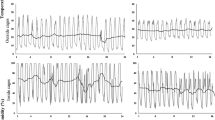Summary
-
1.
In the dune system under observation, Ragwort is distributed in small local populations that have only a restricted lifetime; (temporary) extinction has been observed frequently.
-
2.
Cinnabar Moth attack on these populations is of even shorter duration. Colonization and extinction of the Cinnabar Moth is related to the amount of food present.
-
3.
The presence of the predator Formica polyctena negatively influences the probability of local oviposition.
-
4.
There is a continual shift of the Cinnabar Moth over its food-plant populations. When populations in a favorable food situation in Formica-free habitats became scarce, there was a shift towards populations in Formica habitats.
-
5.
Negative effects of attack on the food-plant populations could be demonstrated, but they were small compared to fluctuations in these populations caused by other factors.
-
6.
After dispersal each year new plant populations providing a favorable food situation are colonized. The heterogeneity of the populations in time and space is the factor that ensures survival of the insect in the system of plant populations.
Similar content being viewed by others
References
Andrewartha, H.G., Birch, L.C.: The Distribution and Abundance of Animals. University of Chicago Press (1954)
Bakker, K.: Backgrounds of controversies about population theories and their terminologies. Zeitschr. angew. Entom. 53, 187–208 (1964)
Birch, L.: The role of environmental heterogeneity and genetical heterogeneity in determining distribution and abundance. In: Proc. Adv. Study Inst. Dynamics Numbers Popul., (P.J. den Boer & G.R. Gradwell, eds.), 109–128 1971
Boer, P.J. den: On the dispersal power of Carabid beetles and its possible significance. In: Dispersal and dispersal power of Carabid beetles, (P.J. den Boer, ed.), Misc. paper 8, Wageningen: Landbouwhogeschool 119–137 1971
Boer, P.J. den: Dispersal power and survival. Misc. papers 14, Wageningen: Landbouwhogeschool 1–90 (1977)
Bornemissza, G.F.: An attempt to control ragwort in Australia with the Cinnabar Moth, Callimorpha jacobaeae (L.) (Arctiidae, Lepidoptera). Austr. J. Zool. 14, 201–243 (1966)
Cameron, E.: A study of the natural control of ragwort (Senecio jacobaea L.). J. Ecol. 23, 265–322 (1935)
Dempster, J.P.: The population ecology of the Cinnabar Moth, Tyria jacobaeae L. (Lepidoptera, Arctiidae). Oecologia (Berl.) 7, 26–67 (1971)
Dempster, J.P.: Animal Population Ecology. London: Academic Press, (1975)
Frick, K.E., Holloway, J.K.: Establishment of the Cinnabar Moth, Tyria jacobaeae L. on Tansy Ragwort in the United States. J. econ. Entom. 57, 152–154 (1964)
Harris, P., Wilkinson, A.T.S., Neary, M.E., Thompson, L.S.: Senecio jacobaea L. Tansy Ragwort (Compositae). Technical communications Commonwealth Institute of Biological Control 4, 97–104 (1971)
Harris, P., Wilkinson, A.T.S., Thompson, L.S., Neary, M.E.: Interactions between the Cinnabar Moth, Tyria jacobaeae L. (Lep.: Arctiidae) and Ragwort, Senecio jacobaea L. (Compositae) in Canada. Proc. 4th Int. Symp. Biol. Control of Weeds, (T.E. Freeman, ed.), 174–180 1978
Lempke, B.J.: Insecten gevangen op het lichtschip ‘Noord Hinder’. Ent. Ber. Amst. 22, 101–111 (1962)
Mabelis, A.A.: The relation between aggression and predation in the Red Wood Ant (Formica polyctena Först.). Neth. J. Zool. 29 (1979)
Meijden, E. van der: Senecio and Tyria (Callimorpha) in a Dutch dune area. In: Proc. Adv. Study Inst. Dynamics Numbers Popul., (P.J. den Boer and G.R. Gradwell, eds.), 390–404 1971
Meijden, E. van der: Experiments on dispersal, late-larval predation, and pupation in the Cinnabar Moth (Tyria jacobaeae L.) with a radioactive label (192Ir). Neth. J. Zool. 23, 430–445 (1973)
Meijden, E. van der: Changes in the distribution pattern of Tyria jacobaeae during the larval period. Neth. J. Zool. 26, 136–161 (1976)
Meijden, E. van der, Waals-Kooi, R.E. van der: Population ecology of Senecio jacobaea in a dune ecosystem. I. Reproductive strategy and the biennial habit. J. Ecol. 67, 131–153 (1979)
Monro, J.: The exploitation and conservation of resources by populations of insects. J. anim. Ecol. 36, 531–547 (1967)
Myers, J.H., Campbell, B.J.: Distribution and dispersal in populations capable of resource depletion. A field study on Cinnabar Moth. Oecologia (Berl.) 24, 7–20 (1976)
Southwood, T.R.E.: Migration of terrestrial arthropods in relation to habitat. Biol. Rev. 37, 171–214 (1962)
Southwood, T.R.E., May, R.M., Hassell, M.P., Conway, G.R.: Ecological strategies and population parameters. Amer. Natur. 108, 791–804 (1974)
Williams, C.B., Cockbill, G.F., Gibbs, M.E., Downes, J.A.: Studies in the migration of Lepidoptera. Trans. R. ent. Soc. London 92, 101–283 (1942)
Author information
Authors and Affiliations
Additional information
Publication of the ‘Meijendel-comité’, new series no. 46
Rights and permissions
About this article
Cite this article
van der Meijden, E. Herbivore exploitation of a fugitive plant species: Local survival and extinction of the Cinnabar Moth and Ragwort in a heterogeneous environment. Oecologia 42, 307–323 (1979). https://doi.org/10.1007/BF00346596
Received:
Issue Date:
DOI: https://doi.org/10.1007/BF00346596




